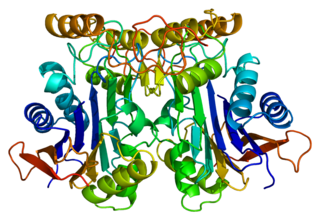
N(4)-(beta-N-acetylglucosaminyl)-L-asparaginase is an enzyme that in humans is encoded by the AGA gene.
The enzyme mannosyl-glycoprotein endo-β-N-acetylglucosaminidase (endoglycosidase H) (EC 3.2.1.96) has systematic name glycopeptide-D-mannosyl-N4-(N-acetyl-D-glucosaminyl)2-asparagine 1,4-N-acetyl-β-glucosaminohydrolase. It is a highly specific endoglycosidase which cleaves asparagine-linked mannose rich oligosaccharides, but not highly processed complex oligosaccharides from glycoproteins. It is used for research purposes to deglycosylate glycoproteins and to monitor intracellular protein trafficking through the secretory pathway.

Asparagine synthetase is a chiefly cytoplasmic enzyme that generates asparagine from aspartate. This amidation reaction is similar to that promoted by glutamine synthetase. The enzyme is ubiquitous in its distribution in mammalian organs, but basal expression is relatively low in tissues other than the exocrine pancreas.
The enzyme N-acetylglucosamine-1-phosphodiester α-N-acetylglucosaminidase (EC 3.1.4.45) catalyzes the reaction
In enzymology, a beta-aspartyl-N-acetylglucosaminidase (EC 3.2.2.11) is an enzyme that catalyzes the chemical reaction

In enzymology, a peptide-N4-(N-acetyl-beta-glucosaminyl)asparagine amidase (EC 3.5.1.52) is an enzyme that catalyzes a chemical reaction that cleaves a N4-(acetyl-beta-D-glucosaminyl)asparagine residue in which the glucosamine residue may be further glycosylated, to yield a (substituted) N-acetyl-beta-D-glucosaminylamine and a peptide containing an aspartate residue. This enzyme belongs to the family of hydrolases, specifically those acting on carbon-nitrogen bonds other than peptide bonds in linear amides.
In enzymology, a 3-galactosyl-N-acetylglucosaminide 4-alpha-L-fucosyltransferase is an enzyme that catalyzes the chemical reaction
In enzymology, a glycoprotein 2-beta-D-xylosyltransferase (EC 2.4.2.38) is an enzyme that catalyzes the chemical reaction
In enzymology, a glycoprotein 3-alpha-L-fucosyltransferase (EC 2.4.1.214) is an enzyme that catalyzes the chemical reaction
In enzymology, a glycoprotein 6-alpha-L-fucosyltransferase (EC 2.4.1.68) is an enzyme that catalyzes the chemical reaction
In enzymology, a N-acetylglucosaminyl-proteoglycan 4-beta-glucuronosyltransferase is an enzyme that catalyzes the chemical reaction
In enzymology, a N-acetyllactosaminide 3-alpha-galactosyltransferase is an enzyme that catalyzes the chemical reaction
In enzymology, a protein N-acetylglucosaminyltransferase is an enzyme that catalyzes the chemical reaction
Alpha-1,3-mannosyl-glycoprotein 2-beta-N-acetylglucosaminyltransferase is an enzyme with systematic name UDP-N-acetyl-D-glucosamine:3-(alpha-D-mannosyl)-beta-D-mannosyl-glycoprotein 2-beta-N-acetyl-D-glucosaminyltransferase. This enzyme catalyses the following chemical reaction
Glucuronosyl-N-acetylglucosaminyl-proteoglycan 4-alpha-N-acetylglucosaminyltransferase is an enzyme with systematic name UDP-N-acetyl-D-glucosamine:beta-D-glucuronosyl-(1->4)-N-acetyl-alpha-D-glucosaminyl-proteoglycan 4-alpha-N-acetylglucosaminyltransferase. This enzyme catalyses the following chemical reaction
Rhamnopyranosyl-N-acetylglucosaminyl-diphospho-decaprenol beta-1,3/1,4-galactofuranosyltransferase is an enzyme with systematic name UDP-alpha-D-galactofuranose:alpha-L-rhamnopyranosyl-(1->3)-N-acetyl-alpha-D-glucosaminyl-diphospho-trans,octacis-decaprenol 3-beta/4-beta-galactofuranosyltransferase. This enzyme catalyses the following chemical reaction
Galactofuranosylgalactofuranosylrhamnosyl-N-acetylglucosaminyl-diphospho-decaprenol beta-1,5/1,6-galactofuranosyltransferase is an enzyme with systematic name UDP-alpha-D-galactofuranose:beta-D-galactofuranosyl-(1->5)-beta-D-galactofuranosyl-(1->4)-alpha-L-rhamnopyranosyl-(1->3)-N-acetyl-alpha-D-glucosaminyl-diphospho-trans,octacis-decaprenol 4-beta/5-beta-D-galactofuranosyltransferase. This enzyme catalyses the following chemical reaction
N-acetylglucosaminyl-diphospho-decaprenol L-rhamnosyltransferase is an enzyme with systematic name dTDP-6-deoxy-beta-L-mannose:N-acetyl-alpha-D-glucosaminyl-diphospho-trans,octacis-decaprenol 3-alpha-L-rhamnosyltransferase. This enzyme catalyses the following chemical reaction
Mannosylglycoprotein endo-beta-mannosidase is an enzyme. This enzyme catalyses the following chemical reaction:

Peptide:N-glycosidase F, commonly referred to as PNGase F, is an amidase of the peptide-N4-(N-acetyl-beta-glucosaminyl)asparagine amidase class. PNGase F works by cleaving between the innermost GlcNAc and asparagine residues of high mannose, hybrid, and complex oligosaccharides from N-linked glycoproteins and glycopeptides. This results in a deaminated protein or peptide and a free glycan.




